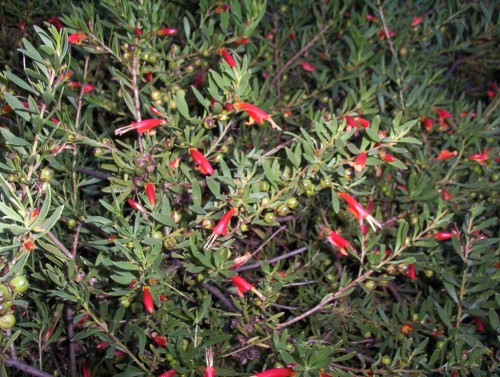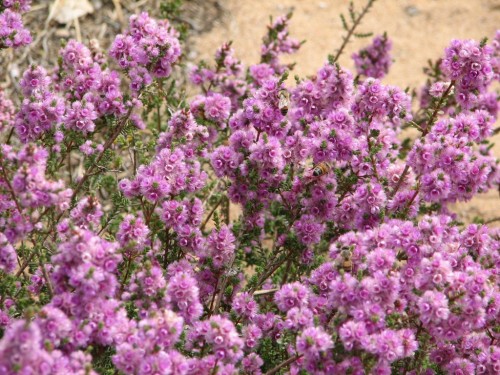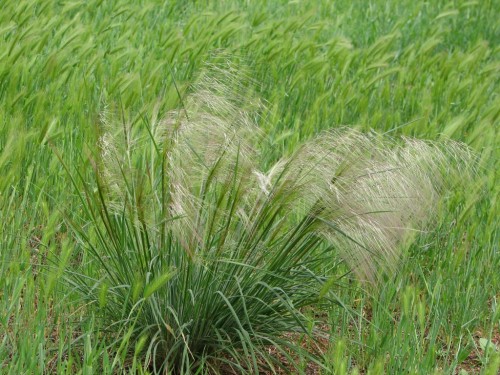Planting Eremophilas
This afternoon I spent some time clearing out gazanias from around the dripper lines and digging holes to replace plants that did not survive a dry period we had a few years ago. I decided that I would put in more eremophilas (emu bushes). The area is very dry but is also the entrance to our place and needs cheering up. Some groundcover Eremophilas will be needed so that they can grow down a small embankment. This is one that I thought would be good as it has proved itself to be very hardy and is flowering prolifically at the moment much to the delight of the New Holland Honeyeaters.
There is a list of hardy eremophilas here.
Xanthorrhoea semiplana (Yacka, Grass Tree)
After the grasses seminar we went to Cromer Conservation Park for a picnic lunch. Husband had been bird watching there and was distracted by the great display of wildflowers. There were a number of these Xanthorrhoea plants in flower. They were growing on deep very well drained sand.
These are often sought after as feature rockery plants. The emphasis is on getting hold of tagged plants, not digging them up in the wild without a permit. Every plant that I have seen ready for transplanting has had the leaves trimmed to around 30cm or less, I assume to reduce transpiration stress.
They do not have an extensive root system. They need good drainage, so raise the planting spot if needed, and give it an open sunny aspect. Keep moist but not soggy, so test the soil in the top 4-5cm for dryness before watering again. I think a mulch of small gravel or course sand, failing that, leaf litter to retain moisture during the summer and keep soil temperature from extremes while the plant is establishing is a good idea.
Growing Plants In Pots
We had unseasonal fierce, hot winds and temperatures last week and a few of my stock plants were scorched badly. A couple of pots had become non-wetting so that when I watered the water passed straight through the pot in channels and also ran down the sides between the pot and mix. This water repelling can be treated with a soil wetter and I used a granular one which has been very effective.
However, in ‘Gardening Down Under’, Kevin suggests that potting mixes are designed to be used in pots to 125mm across and that clean soil should be used in tubs 225mm and larger. I have been thinking about this. I have a load of sandy loam and I think I will try a 50:50 mix of loam and potting mix in the large pots. This way I will still get reasonable drainage and water retention. It won’t stop the pots from heating up. I will need another strategy for that. The other problem is the weight of the pot. At least I will not be wanting to move them often.
The plant in the photo is one of the forms of this Feather Flower. These are sought after by florists. I have never been game to try them in the ground here, as in the wild they grow in fairly deep sand. This would give them very good drainage. Whether the sandy loam/potting mix mixture would work for them is debatable. I want to make a raised bed to try them as well.
Australian Native Grasses
Yesterday I went to a native grasses identification workshop organised by the Native Grasses Resource Group (NGRG) which is based at Mt. Barker in South Australia, about 20 minutes from Adelaide. The workshop was at Mount Pleasant. It was aimed at beginners, which I am, and I hope will give me a few skills to build on so that I can get a reasonable identification of the grasses on our property. Over the last five years I have seen the return of eight species of native grass. There are two more sessions next month. One will be with samples and books, the last out in the field.
The Spear Grasses are well named as the seeds penetrate socks and are quite sharp. They can be a problem with sheep. Apparently there are trials happening with getting stock onto paddocks with spear grass to eat them before seed is set. Being perennial grasses, they resprout when the conditions are right.
I like the plumes on these grasses. This one in the photo was taken last spring after good winter rains as can be seen by the barley grass in head, also. That paddock was mown twice. This year there hasn’t been the growth to warrant mowing.
Useful Book On Gardening
Kevin Handreck’s book, ‘Gardening Down Under’, is another publication of the CSIRO in Australia. Its ISBN is 0 643 05511 8. I found a lot of treasures in it that I had forgotten about. Some are:- different potting mix recommendations for different sized pots, fertilisers for soils and potting mixes, watering regimes, gardening and salty water, raising and lowering soil and mix pH.
He is not only practical in his approach. He also gives the science behind the practical measures he recommends.
With the drought conditions in Australia at the moment, any information about efficient use of water is welcome. There are a lot of recommendations and reasonings in this book which make sense.



